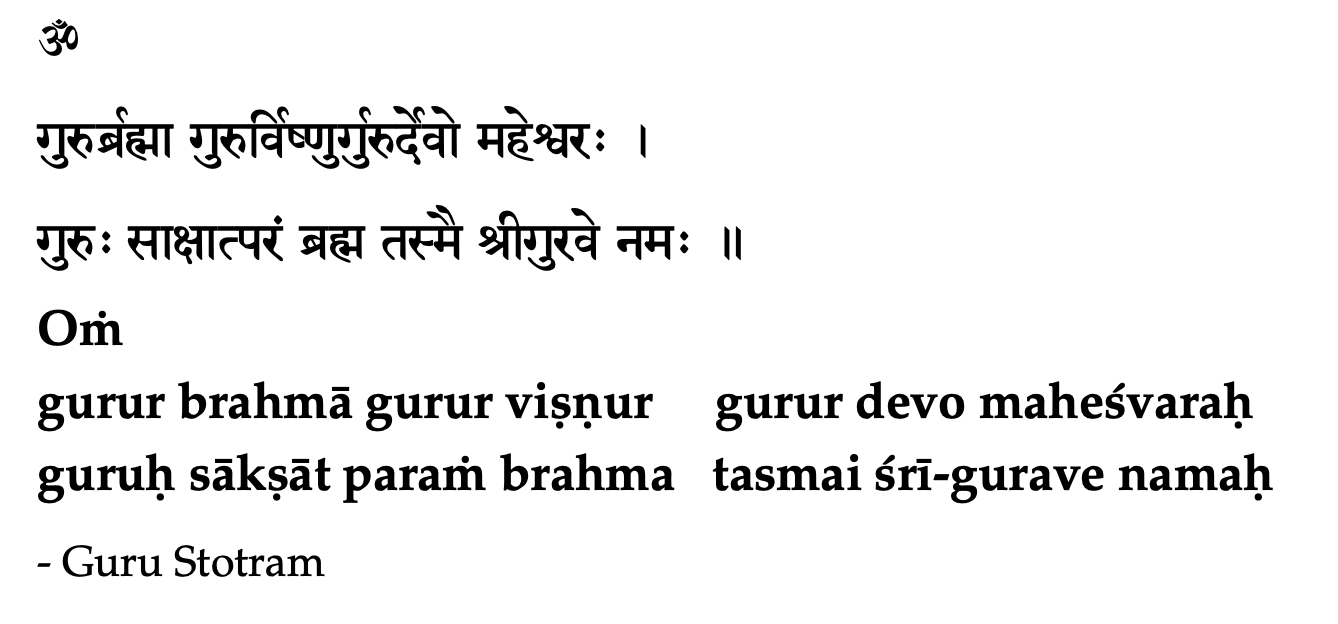The verse, lovingly known as the Guru Chant, comes from the Guru Stotram, a beautiful collection of shlokas drawn from the Guru Gita—a heartfelt song of devotion to the Guru. In recent times, the word “Guru” has sadly taken on some negative associations, largely because of unfortunate incidents involving self-proclaimed “gurus” who have caused harm. This has clouded the true, sacred meaning of what a Guru represents—the embodiment of wisdom and love. Just to clarify, this essay will be about the true Guru, the remover of darkness and the one who could never cause harm, the Guru who is representing God on earth. This is about Guru as a principal that may operate through a person but is within and around us at all times.
The emergence of insincere, self-proclaimed teachers has led to skepticism and fear when it comes to trusting in or following a Guru. Spiritually, this is a significant loss, as the journey of self-realization requires a guiding principle. While many may carry a form of “guru-trauma” from witnessing negative experiences, there is also an element of Western skepticism and defiance. A reluctance to admit the need for guidance, coupled with the belief in self-sufficiency, can hinder spiritual progress. We don’t want to admit that we can’t figure something out on our own and asking for guidance is frowned upon or seen as a failure. After all, who could know better than ourselves? This mindset, while common in the West, isn’t helpful when it comes to spiritual growth. For the sadhaka—the spiritual aspirant—to find truth, the first step is acknowledging and embracing their own ignorance or Avidya.
When it comes to almost every skill we want to learn, we usually seek out someone who knows how to do what we are interested in. And then, depending on how strong and sincere our desire to learn is, we spend as much time with that person as we can. We look over her shoulder, we watch, we copy, we listen, we questions, we try. We learn. Under the guidance of a person who has embodied what we aspire toward.
The relationship between student and Teacher, Sadhaka and Guru is sanctified through the purest form of Love and the highest form of respect and trust. Maybe you are one of the lucky spiritual aspirants who were blessed to have a physical Teacher, one you could talk to and be with. If you are fortunate enough to have or had a Teacher in this world, you might recall that the love, trust, and respect between you and them likely didn’t need to be earned—they were simply present from the start.
A Guru has a very strong energy around and within them, Guru Shakti, that could be described as charismatic but never manipulative and never aimed for fame or approval. Guru Shakti will be tangible and obvious to each earnest spiritual seeker when they meet their teacher. I have often been asked „but how do I find a teacher“ and my answer has always been the same: you will know. It’s like falling in love in the most innocent way. And just like romantically falling in love, you cannot force. It will come. In this life or another.
I personally have been blessed to meet Teachers with capitals Ts and I have experienced the loving, non-judgemental and incredibly healing presence of a true Guru.
I’ve also felt the heartbreak of losing a Teacher to death and witnessing two others stop teaching, at least in the way they once did. Both occasions felt like a spiritual coming of age to me and to be honest I felt pretty lost for a while. But at some point I understood that I have just been initiated and that being a student comes with the responsibility of actually practicing what one has been taught. The love for a Teacher comes with the responsibility to continue their work if they retire, to hold their lives work sacred and to incorporate what is sacred to them.
For those of us who have been entrusted by our Teachers to teach others, it becomes even more crucial to stay true to their teachings and to serve as their voice. This is the beauty of Parampara, a continuous lineage of teachings being passed down from one teacher to the next. When we honor this tradition, we work so that the teachings remain intact and evolving and ready for future transmission; it also becomes easier to stay humble (a key ingredient for a sadhaka). After all, none of the teachings truly belong to us, and the gratitude we receive from students isn’t ours either—it belongs to our Teacher.. Keeping in mind that every teacher is only a student of her own Teacher is very important.
It is not really part of our culture to honor knowledge, wisdom and experience, we would rather fall for money and power. The same thing counts for Yoga: we might seek out the teacher that has the most followers on social media or who can do the fanciest poses, rather than the one who has love and care to match their experience.
The Teachers of our tradition are still around and we can cherish, honor and celebrate them in many ways: We can very respectfully, kindly and persistently ask them to teach again 🙂
And if they happen to agree we have to show up for them! If they are taking a shorter or longer break, we can still pass on what they have taught us, as true to their Teachings possible.
And of course, we can always practice what they have taught us. Which is the biggest gift to a Teacher.


